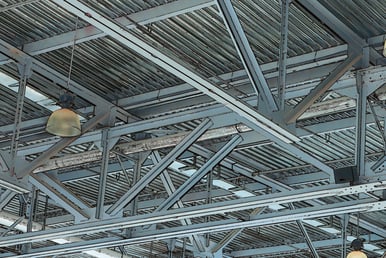 Cleaning the high surfaces throughout a facility can be an overwhelming task, with the network of pipes, ducts, and structural beams crisscrossing over the ceiling collecting dust. This collected dirt can drift down and cause quality, health, and safety hazards. Often though, workers will resort to cleaning this dirt by using compressed air to blow it down. When dealing with combustible dust though, you need to be sure you don’t huff and puff and blow your building down.
Cleaning the high surfaces throughout a facility can be an overwhelming task, with the network of pipes, ducts, and structural beams crisscrossing over the ceiling collecting dust. This collected dirt can drift down and cause quality, health, and safety hazards. Often though, workers will resort to cleaning this dirt by using compressed air to blow it down. When dealing with combustible dust though, you need to be sure you don’t huff and puff and blow your building down.
NFPA 654 (8.2.2.4) clearly states that using compressed air to clean dust accumulations should only be used as a last resort, and only when certain precautions have been taken; it is not to be used for general housekeeping cleaning.
The precautions that must be taken before compressed air is even considered as an option are:
1. The area must be vacuumed, swept, or washed down with water as much as possible first.
2. After this initial cleaning has been performed the remaining dust accumulations should not be more than the allowed limits of combustible dust accumulation.
3. Compressed air hoses should be equipped with a pressure release nozzle to limit the discharge pressure to 30 psi.
4. Any electrical equipment in the area has to meet the requirements of NFPA 70, National Electrical Code.
5. Any possible ignition source that could ignite a combustible dust cloud has to be removed from the area.
Despite these rules in place many people still just try to blow down dust accumulations, and don’t consider the hazard that is created by the dust cloud. When the dust is disturbed into a dust cloud it creates the perfect conditions for the explosion pentagon, and even if obvious ignition sources are removed there will always be ones that you don’t realize.
The safest way to remove these dust accumulations and the way recommended by the NFPA is vacuuming with vacuums designed for explosive materials. Hughes Environmental technicians use electrically grounded, explosion proof vacuums to clean combustible dust safely.
Do you need help cleaning combustible dust in high places?
Contact a Hughes Environmental representative to learn how we can help you avoid fire & explosion hazards in the workplace.

